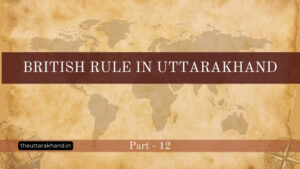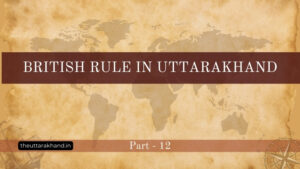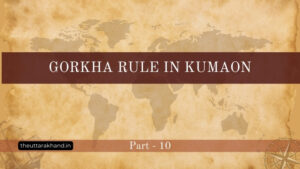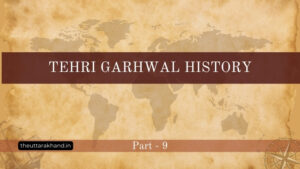Gorkha Rule in Kumaon
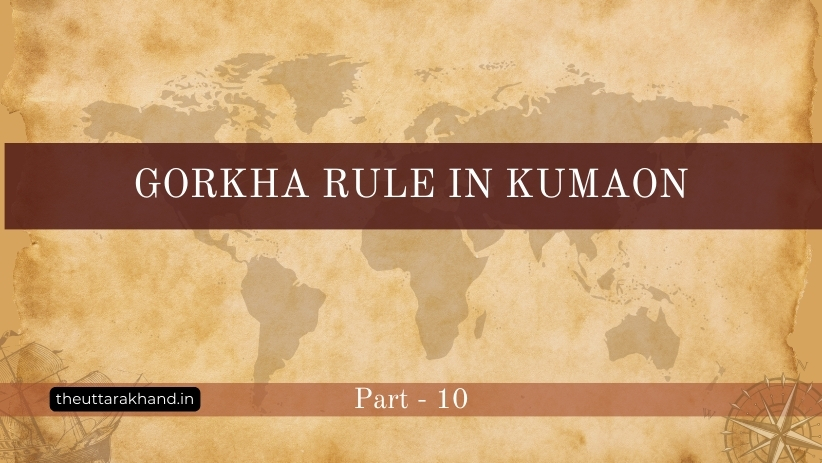
Gorkha Rule in Kumaon
Table of contents
I. Introduction to Gorkha Rule in Kumaon
Gorkha Rule in Kumaon : The Gorkhas are a warrior community hailing from Nepal, who gained prominence in the 18th century due to their military prowess and expansionist ambitions. Their conquests led them to Kumaon, a picturesque region nestled in the lap of the mighty Himalayas. The Gorkha invasion of Kumaon has left an indelible mark on the region’s cultural, social, and political landscape.
Brief History of the Gorkhas
The origins of the Gorkhas date back to the medieval period when they emerged as a distinct ethnic group in western Nepal. Initially, they were divided into small principalities, but in the mid-18th century, King Prithvi Narayan Shah unified these fiefdoms into a single entity, laying the foundation of modern Nepal. His successors continued the policy of expansionism, resulting in conflicts with neighboring countries like China, Tibet, Sikkim, and Bengal.
II. Gorkha Expansion and Invasion of Kumaon
The Chand dynasty ruled over Kumaon since the early 12th century CE, establishing a centralized state with Almora serving as its capital. Despite facing numerous challenges, the Chands maintained their hold over the region until the end of the 18th century when they encountered the rising tide of Gorkha aggression.
Background on the Chand Dynasty
The last ruler of the Chand dynasty, Mahindra Chand, ascended the throne in 1772 CE amidst internal strife and external threats. By this time, the Gorkhas had already consolidated their position in western Nepal and started eyeing the rich resources of Kumaon. Moreover, the weakened state of the Chand empire offered a golden opportunity for the Gorkhas to expand their dominion beyond Nepalese borders.
Reasons for Gorkha Invasion
Several factors contributed to the Gorkha invasion of Kumaon:
- Geopolitical Interests: Kumaon lay along the strategic routes connecting Nepal to plains of North India, providing access to valuable resources and markets. Thus, it presented an irresistible temptation for the ambitious Gorkhas.
- Military Ambition: The Gorkhas prided themselves on their martial traditions and sought to establish their supremacy across the Indian Subcontinent.
- Economic Motives: The fertile valleys of Kumaon promised abundant natural resources and potential economic gains.
- Political Instability: Internal turmoil within the Chand Empire made it vulnerable to external invasions, offering a favorable context for the Gorkha campaign.
With these considerations in mind, the Gorkha army marched towards Kumaon in the late 18th century, determined to assert their authority over the region.
III. Governance under the Gorkhas
When the Gorkhas invaded Kumaon, they brought about major changes in the existing administrative structure, introducing a new system that helped strengthen their grip over the newly acquired territories.
Administrative Structure
Under the Gorkhas, Kumaon was divided into four provinces, namely Kumau, Garhwal, Tarai, and Karnali. Each province was headed by a governor called ‘Subahdar’, appointed directly by the king of Nepal. These governors exercised complete control over the civil, judicial, and military affairs of their respective regions.
Below the provincial level, there were district collectors responsible for maintaining law and order and collecting taxes. Smaller units called parganas were administered by local chieftains, who served as intermediaries between the people and the government.
Land Revenue Collection System (Malgujari Bandobast)
One of the most prominent features of Gorkha governance in Kumaon was the implementation of the Malgujari Bandobast system of land revenue collection. Introduced during the regime of Prime Minister Bahadur Shah, the Malgujari Bandobast replaced earlier forms of land revenue assessment systems prevalent in Kumaon.
Under this system, the entire area was surveyed and assessed, and lands were categorized according to their quality and irrigation facilities available. Based on these categories, fixed rates of revenue were imposed on the cultivators. Every village was assigned a hereditary accountant called ‘Kulkarni’, who kept track of the revenues collected and remitted them to the treasury.
This innovative method of revenue collection not only improved the efficiency of revenue administration but also increased the overall revenue yield for the government. It proved to be a win-win situation for both the authorities and the farmers, ensuring a steady flow of income while simultaneously fostering development activities in the region.
IV. Impact of Gorkha Rule on Kumaon
The advent of Gorkha rule in Kumaon had far-reaching consequences, affecting multiple facets of life, ranging from administration and governance to culture and societal norms.
Changes in Administration and Governance
As mentioned earlier, the Gorkhas restructured the administrative machinery, dividing Kumaon into manageable divisions and appointing efficient officers to ensure smooth functioning. Additionally, they implemented a uniform legal code applicable throughout their territories, thereby eliminating regional disparities and inconsistencies.
However, despite their efforts to streamline the administrative apparatus, the Gorkhas adopted heavy-handed measures to suppress dissent and quell opposition. Torture, arbitrary arrests, and summary executions became commonplace, tarnishing the image of the otherwise well-organized Gorkha administration.
Cultural Impact
On the cultural front, the Gorkha occupation resulted in a fusion of different customs, languages, and practices, giving rise to unique hybrid forms that continue to exist even today. For instance, many Kumaoni festivals now incorporate elements borrowed from Nepalese traditions, reflecting the deep-rooted syncretism evident in the region’s cultural fabric.
Furthermore, the imposition of Nepali as the official language facilitated communication among diverse linguistic groups residing in the region. While this move promoted unity and integration, it also adversely affected local dialects, some of which face extinction owing to waning popularity.
Another notable aspect of Gorkha rule pertains to religious tolerance exhibited by the occupying force. Unlike other colonial powers, the Gorkhas refrained from enforcing their faith upon the subject population, allowing coexistence and mutual respect among adherents of different religions.
Despite certain positive outcomes stemming from Gorkha rule, its negative dimensions cannot be overlooked. The exploitative nature of revenue extraction coupled with oppressive methods employed to quell dissent exacted a heavy toll on the native populace. Nevertheless, the experience of being governed by the Gorkhas significantly shaped the trajectory of Kumaon’s historical evolution, leaving behind a lasting legacy that continues to resonate in the present day.
V. End of Gorkha Rule
The Gorkha Empire’s expansion reached its zenith in the late eighteenth century; however, it did not take long before the British East India Company took notice of the growing power of the Gorkhas in the region. Conflicts between the two powers eventually erupted into full-scale warfare, leading to the downfall of the Gorkha Empire.
Anglo-Gorkha War
The Anglo-Gorkha War was fought between the British East India Company and the Kingdom of Gorkha between 1814 and 1816. The trigger for the conflict was the disputed border between the two empires, specifically regarding the territories of Sikkim and the Terai region. The British East India Company wanted to expand its territories in the region, whereas the Gorkhas saw this as an infringement on their sovereignty.
The initial phase of the war went poorly for the British, who suffered losses in battles such as Makwanpur, Deuthal, and Jaithak. However, the tide turned in favor of the British after General David Ochterlony arrived in India with reinforcements. In May 1815, the combined British and Indian forces captured Kalanga and subsequently forced the Gorkhas to retreat to Kathmandu. On March 24, 1816, the Treaty of Sugauli was signed, officially bringing an end to hostilities between the two parties.
Treaty of Sugauli
The Treaty of Sugauli was negotiated by Major General Sir David Ochterlony and Colonel William Kirkpatrick on behalf of the British East India Company, and Fateh Jung Shah and Raj Durbar on behalf of the Kingdom of Gorkha. According to the treaty, the Gorkhas agreed to relinquish all territories west of the Kali river, including the entire Kumaun Division, to the British East India Company. Furthermore, the Gorkhas recognized the independence of the states of Sikkim, Teesta, and Morang, which previously fell under their sphere of influence.
VI. Legacy of Gorkha Rule in Kumaon
Although the Gorkha Empire no longer exists, its legacy remains deeply etched in the cultural and architectural fabric of the Kumaon region.
Architectural Heritage
During their reign in Kumaon, the Gorkhas built several impressive structures, including temples, palaces, and forts. Some of these buildings remain standing today, showcasing the intricate craftsmanship and attention to detail characteristic of traditional Gorkha architecture. One example is the famous Jageshwar temple complex located near Almora, which dates back to the ninth century AD and is considered one of the twelve jyotirlinga shrines dedicated to Lord Shiva. Another is the majestic Ghorakhal Temple, situated atop a hill overlooking the town of Bhowali, which attracts thousands of devotees annually.
Linguistic Influence
The Gorkha Empire played a crucial role in shaping the linguistic landscape of Kumaon. The Nepali language, spoken by the majority of the Gorkha soldiers, gradually seeped into everyday conversation, becoming the dominant tongue in the region. Today, Nepali is widely used in Kumaon alongside Hindi and English, and serves as the medium of instruction in schools and colleges.
Cultural Influence
Perhaps the most enduring legacy of Gorkha rule in Kumaon lies in its cultural influence. Many of the region’s folk songs, dances, and music bear traces of Gorkha origin, blending seamlessly with indigenous traditions. Similarly, traditional Gorkha cuisine, featuring dishes like thukpa, momos, and sel roti, has become integral to Kumaoni gastronomy. The vibrant culture of Kumaon reflects the amalgamation of various influences, including those from the Gorkha Empire, making it a melting pot of ideas and artistic expression.
Gorkha Rule in Kumaon:
What was the extent of Gorkha rule in Kumaon?
The Gorkha Empire expanded its territories to include parts of what is now Uttarakhand, ruling over the Kumaon region for close to five decades.
How did Gorkha rule affect Kumaon’s architecture?
Gorkha rule in Kumaon led to the construction of iconic structures like the Jageshwar temple complex and the Ghorakhal Temple, reflecting traditional Gorkha architectural styles.
Did Gorkha rule leave a mark on Kumaon’s language?
Yes, the Nepali language, spoken by the majority of Gorkha soldiers, gradually became the dominant tongue in the region.
What cultural impact did Gorkha rule have on Kumaon?
Gorkha rule in Kumaon resulted in the creation of unique folk songs, dances, and music, influencing the region’s art and entertainment scene.

